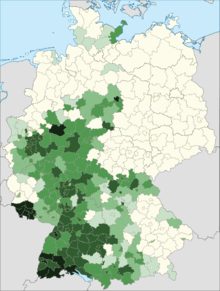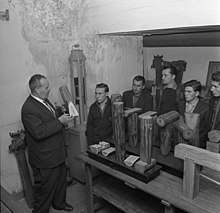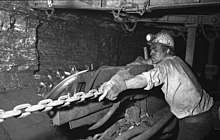Italians in Germany
Italians in Germany consist of ethnic Italian migrants to Germany and their descendants, both those originating from Italy as well as from among the communities of Italians in Switzerland. Most Italians moved to Germany for reasons of work, others for personal relations, study, or political reasons. Today, Italians in Germany form one of the largest Italian diasporas in the world and account for one of the largest immigrant groups in Germany.
 Distribution of Italian citizens in Germany (2014). | |
| Total population | |
|---|---|
| 969,000 (with Italian ancestry) [1] 596,127 (Italian citizens)[2] | |
| Regions with significant populations | |
| Berlin · Hamburg · Munich · Rhein-Ruhr · Frankfurt · Stuttgart · Cologne | |
| Languages | |
| German · Italian · other languages of Italy | |
| Religion | |
| Major Catholicism · Lutheranism · Others | |
| Related ethnic groups | |
| Italian people · other European peoples |
History

Large numbers of Italians have resided in Germany since the early Middle Ages, particularly architects, craftsmen and traders. During the late Middle Ages and early modern times many Italians came to Germany for business, and relations between the two countries prospered. The political borders were also somewhat intertwined under the German princes' attempts to extend control over all the Holy Roman Empire, which extended from northern Germany down to Northern Italy. During the Renaissance many Italian bankers, architects and artists moved to Germany and successfully integrated in the German society.


When the huge Italian emigration of the 19th century began, only a few Italians moved to the German Empire under Prussian rule.
With Germany's post-World War II economic boom (Wirtschaftswunder), a large wave of immigrants from Italy relocated to Germany. Italy and Germany have been joint members of the European Coal and Steel Community (later the European Economic Community). Since the establishment of freedom of movement for workers between the two countries in 1961, more than 580,000 Italians migrated to Germany for work, mainly from southern and north-eastern Italy. Among the German cities Wolfsburg and Ludwigshafen had the highest share of Italian migrants in 2011 according to German Census data. [3]
The workers in the Contemporary Art Museum of Casoria in Naples, Italy, proposed a plea of asylum to Germany.[4]
Organised crime
In 2017 there were 14 organized crime trials of Italian mafia groups. The following groups were involved:[5]
- Ndrangheta, seven trials
- Cosa Nostra, three trials
- Camorra two trials.
The major activity of these groups was cocaine drug trafficking. In these trials 169 suspects were reported, of which 139 were Italian citizens.[5]
Social integration
Italians in Germany are actively involved both in regional and federal German politics; areas of concern are European integration and assimilation.
They also had a substantial influence on the development of Fine Arts in Germany from Romanesque and Gothic architecture to contemporary fashion and design.
Notable people
In general
- Mario Adorf, actor
- Johannes Agnoli, late scientist
- Marco Baldi, basketball player and manager
- Bernhard Bolzano, mathematician, logician, philosopher, theologian and Catholic priest
- Clemens Brentano, poet and novelist
- Lujo Brentano, economist
- Ferruccio Busoni, composer, pianist, conductor, editor, writer, and piano teacher
- Roberto Cappelluti, TV presenter
- Mandy Capristo, singer and songwriter
- Leo von Caprivi, general and statesman
- Rudolf Caracciola, racing driver
- Lars Castellucci, politician
- Sandro Cortese, motorcycle racer
- Fabio De Masi, politician
- Enrico Di Ventura, rapper, better known as Italo Reno
- Johann Maria Farina, perfumier
- Romano Guardini, Catholic priest, author, and academic
- Vittorio Hösle, philosopher
- Toni Landomini, rapper, better known as Toni L
- Giovanni di Lorenzo, journalist
- Bruno Maderna, conductor and composer
- Denis Moschitto, actor
- Victor Perli, politician
- Marcello Pirani, scientist
- Franka Potente, actress
- Raphael Ragucci, rapper, better known as RAF Camora
- Calogero Randazzo, rap music producer, better known as Roey Marquis II.
- Graciano Rocchigiani, boxer
- Ralf Rocchigiani, boxer
- Daniel Sluga, rap music producer, better known as Fader Gladiator
- Jessica Tatti, politician
- Ingo Zamperoni, TV presenter and journalist
- Giovanni Zarrella, singer and TV presenter
Football players
See also
Bibliography
- Johannes Augel, Italienische Einwanderung und Wirtschaftstätigkeit in rheinischen Städten des 17. und 18. Jahrhunderts, Bonn, L. Röhrscheid, 1971.
- Gustavo Corni, Christof Dipper (eds), Italiani in Germania tra Ottocento e Novecento: spostamenti, rapporti, immagini, influenze, Bologna, Il Mulino, 2006, ISBN 88-15-10731-2.
- Marco Fincardi, Emigranti a passo romano: operai dell'Alto Veneto e Friuli nella Germania hitleriana, Verona, Cierre, 2002, ISBN 88-8314-179-2.
- Malte König, Racism within the Axis: Sexual Intercourse and Marriage Plans between Italians and Germans, 1940–3, in: Journal of Contemporary History 54.3, 2019, pp. 508-526.
- Brunello Mantelli, Camerati del lavoro. I lavoratori emigrati nel Terzo Reich nel periodo dell'Asse 1938-1943, Scandicci, La Nuova Italia, 1992.
- Claudia Martini, Italienische Migranten in Deutschland: transnationale Diskurse, Hamburg, D. Reimer, 2001, ISBN 3-496-02496-8.
- Edith Pichler, Ethnic economics: the Italian entrepreneurs in Germany, in: Chiapparino, F. (ed.), The Alien Entrepreneur, Milano, 2011, pp. 54-82.
- Edith Pichler, 50 anni di immigrazione italiana in Germania: transitori, inclusi/esclusi o cittadini europei?, in: Altreitalie, International journal of studies on Italian migrations in the world, Nr. 33, pp. 6-18. Torino, 2006.
- Edith, Pichler, Junge Italiener zwischen Inklusion und Exklusion. Eine Fallstudie. Berlin, 2010.
- Edith, Pichler, Dai vecchi pionieri alla nuova mobilità. Italiani a Berlino tra inclusione ed esclusione, in: De Salvo, E./Ugolini, G./Priori, L. (eds), Italo-Berliner. Gli italiani che cambiano la capitale tedesca, Milano-Udine, Mimesis, 2014.
References
- https://www.heise.de/tp/features/Die-Herkunftsstaaten-der-in-Deutschland-lebenden-Auslaender-3897188.html?seite=all
- https://www.destatis.de/DE/Publikationen/Thematisch/Bevoelkerung/MigrationIntegration/AuslaendBevoelkerung.html?nn=68748
- "Kartenseite: Italiener in Deutschland - Landkreise". kartenseite.wordpress.com. 2017-03-26. Retrieved 2017-04-19.
- 'A Warning Scream from Italian Art': Naples Museum Requests Asylum in Germany Der Spiegel 2011-02-07
- "BKA - Bundeslagebilder Organisierte Kriminalität - Bundeslagebild Organisierte Kriminalität 2017". www.bka.de (in German). p. 20. Archived from the original on 2018-08-11. Retrieved 2018-08-11.